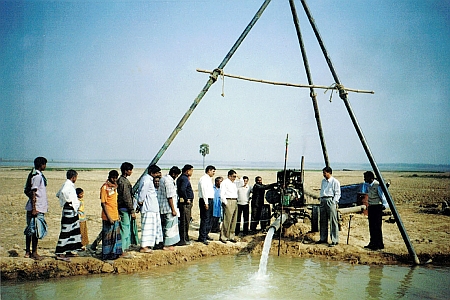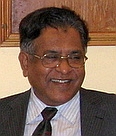Dr Asaduz Zaman talks about the innovative approach his organization took to sustainable irrigation management in Bangladesh, which he recently presented at Asia Water Week in Manila, Philippines.
IWMI’s Anna Deinhard talks to Dr Asaduz Zaman about the innovative approach his organization took to sustainable irrigation management in Bangladesh, which he recently presented at Asia Water Week in Manila, Philippines.

Photo: Asaduz Zaman
In the Barind region of Bangladesh rainfall is highly seasonal and poverty is endemic. Farmers with few resources were only able to grow one crop per year. In the late 1980s the Barind Multipurpose Development Authority was set up to explore ways of improving livelihoods through sustainable farm irrigation. New rice varieties that could grow in a relatively dry environment were introduced. To reduce water loss through evaporation an extensive network of tube wells and a pipe system were sunk into the ground as a replacement for surface irrigation channels.
Farmers still had to pay for access to water but cash transactions were replaced with a pre-paid swipe-card system for pump usage. This helped avert corruption and led to more optimal water usage, allowing more farmers access to groundwater and an expansion of irrigable land by over a fifth. Aside from poverty elimination, the project’s major driver, other positive changes were observed. The electricity network, for instance, that was set up to run the pumps led to improved household electrification and the operation of a rice mill.
IWMI: The Barind model of irrigation management has proved such a success that the ADB is now planning to replicate it in other regions. What was Barind like before the project, and what changes did you achieve?
AZ: The farmers used to be very dependent on rainfall to grow a (variety of) monsoon rice crop. Consequently farm laborers (the poorest residents in the region, and therefore a key target for the project) could only work for around 4 months each year and then had to move elsewhere to sustain their lives. In addition rainfall in Barind used to be the lowest in the country and desertification started to become a problem.
Now after the implementation the farm labourers seem actually happier than land owners. They have work through the year and are even able to bargain. The demand for female labour has risen a lot too for certain agricultural practices.
Desertification is unheard of today. Irrigation wells are now performing a dual purpose for drinking water supply through pipe distribution system with overhead tank.
What were the challenges farmers had to deal with?
Well, first of all farmers did not have experience in how to grow seeds for Boro (the new dry season rice variety), which we introduced as an alternative to monsoon rice. It is a totally different procedure, so famers had to be trained. Knowledge of crop diversification and high value crops were also a totally new concept to the farmers.
In your presentation you highlighted the “Pre-paid-meter system. What is special about it and how does it work?
From the beginning of the project, we had the intention to avoid cash money and introduce a prepaid system for the irrigation system. Initially we started a coupon system, printing coupons from a government press. But even though, we ended up having problems with corruption and found the coupons being replicated on a local press. The police had to intervene. It was then that I started thinking about the swipe cards.
How was the system perceived by the farmers and other users?
At first some of the MPs and also some of the farmers seemed a bit reluctant. However soon after introduction of the new system those farmers came back and said, “This is good. We are saving money, water and time.”
Do you think the model could be replicated in, for instance, India?
Back in 2004-05 when we introduced the pre-paid meter it still seemed very high tech, but I would say it is very easy to introduce nowadays. I am confident the model could be replicated in India for irrigation purposes.
In your opinion which are critical factors for the success of a replication?
I think the Irrigation project authority should introduce the provision of incentives and penalties for good and bad performances respectively. Then there are matters of infrastructure, all wells should be electrified. The area should be brought under a buried plastic pipe water distribution system. But these factors are not impossible to achieve.
Last but not the least I think the chief executive of a successful irrigation project should have a clear idea about people, land and water.
 About the interviewee: About the interviewee:Dr. Asaduz Zaman from Bangladesh has 40 years of work experience in groundwater and surface water irrigation management. He worked with the Barind Multipurpose Development Authority (BMDA), where he was responsible for the implementation of an irrigation project known as “Barind model”. Presently he is working with the Asian Development Bank (ADB) on a replication of this model. |

